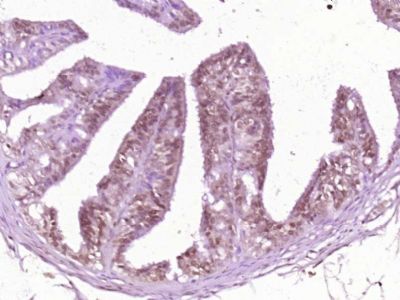RAD21L1 Polyclonal Antibody
Purified Rabbit Polyclonal Antibody (Pab)
- SPECIFICATION
- CITATIONS
- PROTOCOLS
- BACKGROUND

Application
| IHC-P, IHC-F, IF, ICC, E |
|---|---|
| Primary Accession | Q9H4I0 |
| Reactivity | Rat |
| Host | Rabbit |
| Clonality | Polyclonal |
| Calculated MW | 63 KDa |
| Physical State | Liquid |
| Immunogen | KLH conjugated synthetic peptide derived from human RAD21L1 |
| Epitope Specificity | 101-200/556 |
| Isotype | IgG |
| Purity | affinity purified by Protein A |
| Buffer | Preservative: 0.02% Proclin300, Constituents: 1% BSA, 0.01M PBS, pH7.4. |
| SUBCELLULAR LOCATION | Nucleus. Chromosome. Note: In meiotic chromosomes, localized along axial elements in early meiosis: detectable on the axial elements in leptotene, and stays on the axial/lateral elements until mid pachytene. It then disappears and is replaced with RAD21. Compared to REC8, has mutually exclusive loading sites on the chromosomes: REC8 and RAD21L form distinct cohesin-enriched domains along the axial elements. |
| SIMILARITY | Belongs to the rad21 family. |
| SUBUNIT | Component of some meiotic cohesin complex composed of the SMC1 (SMC1A or SMC1B) and SMC3 heterodimer attached via their hinge domain, RAD21L which link them, and STAG3. |
| Important Note | This product as supplied is intended for research use only, not for use in human, therapeutic or diagnostic applications. |
| Background Descriptions | Function: Meiosis-specific component of some cohesin complex. Probably required during early meiosis for separation of sister chromatids and homologous chromosomes. Replaces RAD21 in premeiotic S phase (during early stages of prophase I), while RAD21 reappears in later stages of prophase I. May be involved in synapsis initiation and crossover recombination between homologous chromosomes. Subunit structure: Component of some meiotic cohesin complex composed of the SMC1 (SMC1A or SMC1B) and SMC3 heterodimer attached via their hinge domain, RAD21L which link them, and STAG3. Sequence similarities Belongs to the rad21 family. |
| Gene ID | 642636 |
|---|---|
| Other Names | Double-strand-break repair protein rad21-like protein 1, RAD21L1, RAD21L |
| Target/Specificity | Specifically expressed in male and female gonads (at protein level). |
| Dilution | IHC-P=1:100-500,IHC-F=1:100-500,ICC=1:100-500,IF=1:100-500,ELISA=1:5000-10000 |
| Format | 0.01M TBS(pH7.4), 0.09% (W/V) sodium azide and 50% Glyce |
| Storage | Store at -20 ℃ for one year. Avoid repeated freeze/thaw cycles. When reconstituted in sterile pH 7.4 0.01M PBS or diluent of antibody the antibody is stable for at least two weeks at 2-4 ℃. |
| Name | RAD21L1 |
|---|---|
| Synonyms | RAD21L |
| Function | Meiosis-specific component of some cohesin complex required during the initial steps of prophase I in male meiosis. Probably required during early meiosis in males for separation of sister chromatids and homologous chromosomes. Replaces RAD21 in premeiotic S phase (during early stages of prophase I), while RAD21 reappears in later stages of prophase I. Involved in synaptonemal complex assembly, synapsis initiation and crossover recombination between homologous chromosomes during prophase I (By similarity). |
| Cellular Location | Nucleus {ECO:0000250|UniProtKB:A2AU37}. Chromosome {ECO:0000250|UniProtKB:A2AU37}. Note=In meiotic chromosomes, localized along axial elements in early meiosis: detectable on the axial elements in leptotene, and stays on the axial/lateral elements until mid pachytene. It then disappears and is replaced with RAD21 Compared to REC8, has mutually exclusive loading sites on the chromosomes: REC8 and RAD21L form distinct cohesin-enriched domains along the axial elements. {ECO:0000250|UniProtKB:A2AU37} |

Thousands of laboratories across the world have published research that depended on the performance of antibodies from Abcepta to advance their research. Check out links to articles that cite our products in major peer-reviewed journals, organized by research category.
info@abcepta.com, and receive a free "I Love Antibodies" mug.
Provided below are standard protocols that you may find useful for product applications.
If you have used an Abcepta product and would like to share how it has performed, please click on the "Submit Review" button and provide the requested information. Our staff will examine and post your review and contact you if needed.
If you have any additional inquiries please email technical services at tech@abcepta.com.













 Foundational characteristics of cancer include proliferation, angiogenesis, migration, evasion of apoptosis, and cellular immortality. Find key markers for these cellular processes and antibodies to detect them.
Foundational characteristics of cancer include proliferation, angiogenesis, migration, evasion of apoptosis, and cellular immortality. Find key markers for these cellular processes and antibodies to detect them. The SUMOplot™ Analysis Program predicts and scores sumoylation sites in your protein. SUMOylation is a post-translational modification involved in various cellular processes, such as nuclear-cytosolic transport, transcriptional regulation, apoptosis, protein stability, response to stress, and progression through the cell cycle.
The SUMOplot™ Analysis Program predicts and scores sumoylation sites in your protein. SUMOylation is a post-translational modification involved in various cellular processes, such as nuclear-cytosolic transport, transcriptional regulation, apoptosis, protein stability, response to stress, and progression through the cell cycle. The Autophagy Receptor Motif Plotter predicts and scores autophagy receptor binding sites in your protein. Identifying proteins connected to this pathway is critical to understanding the role of autophagy in physiological as well as pathological processes such as development, differentiation, neurodegenerative diseases, stress, infection, and cancer.
The Autophagy Receptor Motif Plotter predicts and scores autophagy receptor binding sites in your protein. Identifying proteins connected to this pathway is critical to understanding the role of autophagy in physiological as well as pathological processes such as development, differentiation, neurodegenerative diseases, stress, infection, and cancer.


